Last updated: February 10, 2025
Article
Science and Natural Resource Management for the National Parks: Milestones, 1916–2016
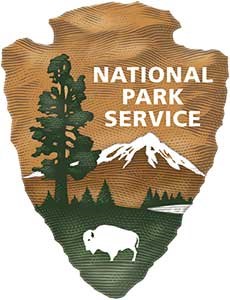
1916
The Organic Act gives birth to the National Park Service (NPS), declaring that the purpose of the bureau is “to conserve the scenery and the natural and historic objects and the wild life therein and to provide for the enjoyment of the same in such a manner and by such means as will leave them unimpaired for the enjoyment of future generations.” The law is a complex mandate for preservation combined with the purpose of managing the parks as spaces for human activity. Over the coming century, science will prove invaluable for understanding the workings of nature and our history as a nation, and how best to serve and manage the parks and visitors.
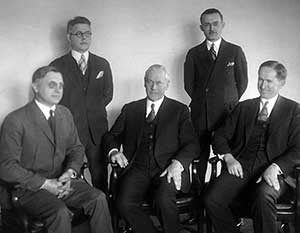
NPS Photo / Harpers Ferry Center
1916
Stephen Tyng Mather becomes the first director of the NPS, serving until 1929. He is the first of many leaders to declare that use by the public is the Service’s prime mandate. This leads to an ebb and flow of support for science in the parks over many decades.
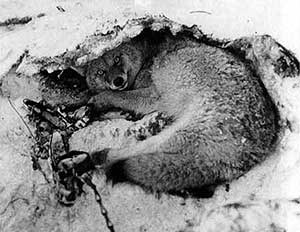
NPS Photo
1916–1930s
Predator control has been a major feature of wildlife management from the first settlement of the West. Since the Service’s earliest days, park managers see coyotes, wolves, and bears as a danger to ungulates such as deer, antelope, and even bison, which are an attraction for park visitors. Many of these predators are endangered by the 1930s in many western parks, with some being hunted to the point that they disappear from these ecosystems.
1918
NPS Acting Director Horace Albright drafts a letter for Secretary Lane to send to convalescing Director Mather outlining policies for the parks. Visual harmony is paramount in Lane’s mind, so if park uses keep the public areas beautiful, then they could be allowed. Science is used to ensure preservation of visual landscapes, not of ecosystems. The letter reflects the tensions surrounding the concepts of conservation, also referred to as wise use, and preservation, which calls for keeping nature in a more pristine condition.
1925
The Yosemite Field School of Natural History is the first center of its kind in the NPS, embodying principles of parks as places for education and study, and offering intensive training to NPS nature guides.

NPS History Collection, Photo by Roger Wolcott Toll
1929
George Melendez Wright, an NPS biologist, bankrolls a program in Yosemite to begin research on animals, plants, and their related ecosystems. His work will spread throughout the park system and will be codified in Faunas 1 and 2 (see 1933). Wright’s untimely death in 1936 will mark the start of a long decline in scientific research in the parks.
1929
Albright becomes NPS director (see photo from 1916), serving until 1933. He continues Mather’s emphasis on park development, but he does provide for an increase in funding, staffing, and visibility for a biological approach to park management. During this era, scientists and managers debate what constitutes pristine wilderness and how it might be preserved. Biologists, both in and out of the Service, argue for study and preservation but Albright asserts that certain areas, left undeveloped, can be considered wilderness.
1933
George M. Wright, Joseph S. Dixon, and Ben H. Thompson issue Fauna of the National Parks of the United States: A Preliminary Survey of Faunal Relations in National Parks, Contributions of Wild Life Survey. Frequently referred to as Fauna 1, it lays out some of the needs these scientists see in managing wildlife in the national parks. One concern is possible habitat degradation from introduction of invasive animal and plant species. See the 1990s for more on this.
1936
Science Monthly (36:483–501) publishes Horace Albright’s 1933 article, “Research in the National Parks,” endorsing it as “fundamental” to the protection of park natural features.

NPS History Collection, Photo by Victor H. Cahalane
1937
Brothers Adolph and Olaus Murie are early biologists working in Yellowstone when Adolph begins to conduct the first comprehensive survey of coyotes. He determines that coyote predation does not have a significant negative impact on ungulate population levels and can help control overpopulation of herd animals. In 1939 he will move his research to Mt. McKinley (now Denali) National Park in Alaska, doing the same type of survey of wolves. His work on this species will inform park management for decades to come.
1942
Director Newton Drury bans the ritual of park rangers entertaining visitors with nightly bear feedings in Yellowstone’s garbage dumps. This does not, however, end the practice of visitors feeding bears from their camps and cars. The interactions do not always end well, and the National Park Service will again take up the issue of wildlife habituation in the 1960s.
1946
Willard Libby publishes a report documenting field tests at what is today Tule Springs Fossil Beds National Monument, Nevada, of his carbon-14 dating theory. His work on ice age fossils there proves that this dating technique is an effective means of determining age for organic objects. Willard will receive a Nobel Prize in Chemistry for this work in 1960.
1950s
Fire management policy in the national parks had always been total suppression. However, scientists studying the role of fire near Sequoia and Kings Canyon National Parks begin to change managers’ perceptions. At Everglades National Park, Bill Robertson’s studies of fire in the slash pine ecosystem result in the first prescribed burn in NPS history there in 1958 (see Science and Scientists, 1968).
1959
Biologists Frank and John Craighead begin research on Yellowstone grizzly bears that have continued to use garbage dumps for their major food source. As the NPS considers immediate closure of the dumps, the Craigheads argue for a more gradual approach to allow the bears time to adapt and find natural food. New policies will discourage visitors from feeding bears in campsites and on roadsides. Rangers will relocate problem bears, and those that become nuisances will be killed if they return.
1963
Two influential reports connect science with effective resource management. Wildlife Management in the National Parks (known as the Leopold Report) and the Robbins Report of the National Academy of Sciences call for systematic study of national park ecosystems and natural resources. They document the need for increased NPS funds and staff to carry out the required studies. The Leopold Report calls for preserving “vignettes of primitive America” but leads to an increased understanding that park resources cannot be preserved in a fixed state.

NPS History Collection, Photo by Cecil W. Stoughton
1964
Director George Hartzog creates the Division of Natural Science Studies and appoints National Science Foundation scientist George Sprugel, Jr., as chief scientist. In 1966 Hartzog will elevate the role of park science by designating the division as an office that reports directly to him.
1967
Director George Hartzog appoints Starker Leopold as NPS chief scientist. Son of famed biologist and writer Aldo Leopold, Starker chaired the commission that produced the influential 1963 Leopold Report. In frustration, Leopold will resign in 1968 because of resistance to science programs on the part of park managers.
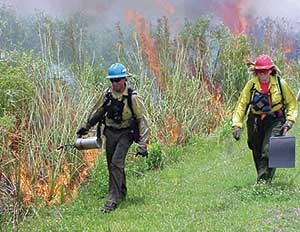
NPS Photo
1968
The National Park Service begins to accept a more natural role of fire in park ecosystems. A shift in policy allows for lightning-ignited wildfires to burn out under certain conditions and for human-ignited prescribed burns to be used to simulate the effects of natural fire. By the late 1980s, several dozen parks will be approved to use one or both provisions of the policy.
1969
The National Environmental Policy Act, passed this year, and the Endangered Species Act, to be passed in 1973, require federal agencies to use best available science to analyze environmental impacts of agency actions and contribute to the protection and recovery of imperiled species and their habitats.
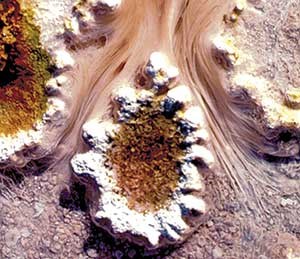
Yellowstone National Park/Fred Hirschmann
Late 1960s
Thomas Brock and Hudson Freeze (Indiana University) discover Thermus aquaticus, a bacterium that can survive in waters up to 160°F, in hot springs at Yellowstone. In 1983, biochemist Kary Mullis (Cetus Corporation) will develop a process called the polymerase chain reaction for replicating DNA in research, for which he will receive the Nobel Prize in Chemistry. In 1985, colleagues of Mullis will isolate an enzyme from a specimen of this bacterium obtained from the American Type Culture Collection that speeds up the reaction. The resulting process will transform microbiology with applications in forensics and medicine. This will lead to a debate about who should share in monetary benefits derived from publicly owned and managed natural resources.
1970
The first Cooperative Park Studies Unit (CPSU) network pairs the NPS with the University of Washington. This is the first of 23 such collaborations across the nation that give students at participating universities hands-on experience in national parks. Park Service personnel also begin to teach in the universities, sharing their practical knowledge of the application of science to park management.
1973–1989
James Quinlan and other researchers work to determine the extent of the karst system in the greater Mammoth Cave National Park area. They document groundwater flow paths and contamination into the park from Horse Cave, Park City, and rural areas. Their work leads to a regional sewer system to protect park resources and results in better legal protection of water quality not only in Kentucky but also in other areas with karst resources.
1975
The Yellowstone grizzly bear is placed on the Endangered Species list. There are many reasons for this, including the killing of dangerous bears by park managers and loss of habitat. The population decline underscores the poor understanding of bear behavior because of inadequate scientific research on the species’ dietary habits. Additional research, extending into the 1980s, will bring policy changes that will lead to innovations in bear management.
1977
President Jimmy Carter signs the Clean Air Act Amendments, which set forth extra protections for air quality in national parks and wilderness areas from air pollution and establish a national visibility goal of “the prevention of any future, and the remedying of any existing, impairment of visibility … from manmade air pollution” affecting these areas. The amendments recognize that air quality in national parks should not be degraded.
1978
The act to establish Redwood National Park (1970) is amended, reaffirming that the highest standard of protection and care should be afforded to management of the resources, values, and purposes for which parks have been established. Uses must be consistent with the Organic Act and only Congress may direct deviation from this standard.
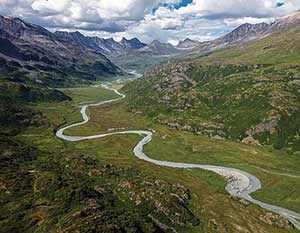
NPS Photo / Jacob W. Frank
1980
Passage of the Alaska National Interest Lands Conservation Act adds more than 43 million acres to the National Park System and has major implications for natural science support for management of these lands.
1980
The NPS Pacific Northwest Region launches Park Science, a bulletin linking research findings and resource management. After three issues it will go national, and in 1996 will be published online. By 2016 nearly 100 issues will have appeared in print and online.
1982
The Natural Resource Trainee Program is a two-year operation that will run six times until 1993, giving NPS employees the opportunity to become experts in natural resource management. Approximately 200 people will complete the course, including Jon Jarvis, NPS director from 2009 to 2017.
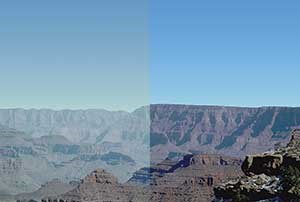
NPS Visibility Photo from Improve/Cira Website
1985
The National Park Service leads the effort to establish the Interagency Monitoring of Protected Visual Environments (IMPROVE) network to assess visibility degradation at national parks and wilderness areas, which implements provisions of the 1977 Clean Air Act Amendments. The airborne chemical monitoring network will grow from a few sites initially to more than 150 across the nation by 2016.
1988
A massive complex of wildfires in Yellowstone burns nearly 800,000 acres of the park over several months. The effects of the disruptive fires have far-reaching implications. Though NPS fire policy is deemed sound, better understanding of environmental conditions and potential impacts will be required before making future fire management decisions. Public understanding of the ecological role of fire will increase.
1989
An NPS task force develops plans for rigorous and integrated inventory and monitoring (I&M) throughout the National Park System. In 1993 the NPS will publish NPS-75, “Inventory and Monitoring Guidelines.” Seven pilot parks will test initial long-term ecological monitoring strategies. Large-scale implementation of this program will ultimately result in 32 monitoring networks that support science-informed decision making across the National Park System.
1991
The National Park Service convenes a high-profile management conference in Vail, Colorado. Attended by leaders from the NPS and outside groups, including environmental organizations, it brings to the fore, among other things, the uneven progress in park science that has characterized the first 75 years of NPS history. The subsequent Vail Agenda calls for more resources for park science, especially resources for science-based inventories and management plans.
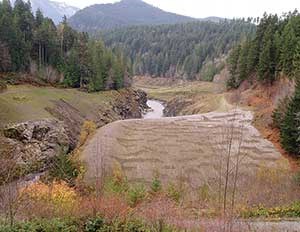
NPS Photo
1992
The National Park Service, in partnership with the Lower Elwha Tribe and the Bureau of Reclamation, begins planning for the removal of two dams on the Elwha River in and adjacent to Olympic National Park, Washington. This represents a shift in restoration to ecosystems, with science playing an important role in the decision-making process. The plan will restore the Elwha River ecosystem, including migration of native salmon and steelhead to areas in the park for the first time in more than 100 years. Removal of the dams will be completed by 2014.
1993
Secretary of the Interior Bruce Babbitt creates the National Biological Survey, combining research scientists from the NPS, Bureau of Land Management, US Fish and Wildlife Service, and other bureaus to strengthen DOI research. The NPS contributes 168 full-time scientists and support staff and $20 million in base funds to the endeavor. This effectively removes researchers from NPS control, although natural resource managers remain in the NPS. The National Park Service will go on to develop new mechanisms to facilitate park science through the advent of Cooperative Ecosystem Studies Units (CESUs), research learning centers (RLCs), and improvements in position management (Resource Careers).
1994
Marjorie Stoneman Douglas is awarded the Presidential Medal of Freedom for her role in raising public concern about the effects of water diversion and wildlife disturbances in the Everglades. This will lead to better protection and restoration of the area and highlights the importance of ecological restoration throughout the National Park System.
1994
An angler catches a nonnative lake trout in Yellowstone Lake, a predatory threat to the native population of cutthroat trout. Purple loosestrife threatens to overrun native plants in parks in the northeastern United States. Invasive species are increasingly a primary concern of resource managers across the National Park System who strive to preserve and restore native ecosystems. In response, a federal interagency committee (FICMNEW) forms, bringing 16 federal agencies together to deal with managing invasive plant species.
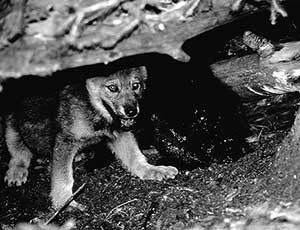
NPS / Yellowstone National Park
1995
Seventeen gray wolves from Canada are restored to Yellowstone. This highly controversial program creates a stable population of wolves in just one year. However, ranchers outside the park occasionally experience wolf depredation on their cattle, leading to calls to remove the wolves. Park scientists respond by setting up management and compensation programs and enhancing collaboration with state and local wildlife managers.
1996
The first NPS “bioblitz” is held at Kenilworth Park and Aquatic Gardens in Washington, DC. A bioblitz is a field activity that brings together professional and citizen scientists to do biodiversity surveys.
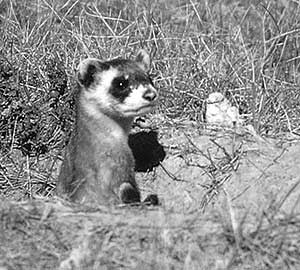
NPS / Badlands National Park
1996
Black-footed ferrets are restored to Badlands National Park, South Dakota. Once thought to be extinct, these predatory mammals become part of the native ecosystem, living once again in and around the park’s many prairie dog colonies.
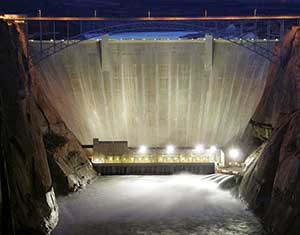
U.S. Bureau of Reclamation
1996
The Bureau of Reclamation releases 45,000 cubic feet per second of water from Glen Canyon Dam into the Colorado River. This flush lasts one week and scours the area below the dam. The adaptive management experiment helps to reestablish sandbars and rebuild riparian and aquatic habitats in Grand Canyon to more closely resemble the riverscape before the dam’s construction in 1965.
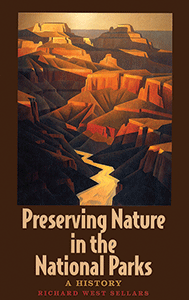
Copyright 1997 Yale University
1997
Richard Sellars’s Preserving Nature in the National Parks examines the erratic history of scientifically informed management policies for natural resources in the national parks. It results in careful reassessment of the need to put science at the forefront of park operations. See 1999 for the further impact of this book.
1998
The Canon National Parks Science Scholars Program starts providing scholarships to allow PhD students to do research in parks. By 2006, nine years into the planned 10-year program, more than 75 students will have participated, conducting research in more than 90 national parks across the Americas. The program illustrates how philanthropic support and corporate-public partnerships—in this case between Canon U.S.A., the sponsor, and the National Park Foundation, which awarded the grants—can help facilitate “Parks for Science.”
1998
The National Parks Omnibus Management Act becomes law and elevates science and resource management in the National Park Service. One of its purposes is to “enhance management and protection of national park resources by providing clear authority and direction for the conduct of scientific study in the National Park System and to use the information gathered for management purposes.”
1999
The Natural Resource Challenge makes resource management and ecosystem preservation two of the bureau’s top priorities. It nearly doubles the NPS natural science budget for five years, providing for resource inventories through a network-based science program and other information products and resource management services. NPS Director Robert Stanton credits Richard Sellars’s book with providing the idea for the Challenge.

1999
The first island foxes at Channel Islands National Park are captured as part of a breeding program established to bolster the species’ declining numbers. Monitoring had detected rapid decline by 1995. Thanks to a comprehensive, partnership-driven conservation effort, in 2016 three fox subspecies will be removed from the Endangered Species List, representing the fastest ever successful recovery of a listed mammal.1999
The National Park Service helps establish the network of Cooperative Ecosystem Studies Units (CESUs), and the first 4 of 17 eventual units begin operation. This gives parks access to research, technical assistance, and educational products by working with academic institutions located in biogeographic networks across the country.
2000
As a result of increased understanding and recognition of the importance of the acoustic environment in national parks, Congress passes the National Parks Air Tour Management Act, which requires the NPS and the Federal Aviation Administration to mitigate or prevent adverse impacts of commercial air tour operations on park resources and values.
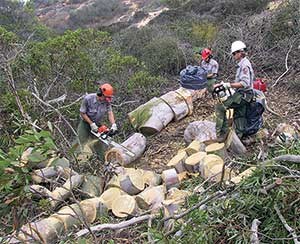
NPS Photo
2000
Exotic Plant Management Teams begin to organize and control nonnative plants on park sites. By 2007 the 16 teams working in 189 parks will have treated more than 49,000 acres. This includes removing purple loosestrife from Apostle Islands National Seashore and melaleuca from Big Cypress National Preserve.
2001
The Natural Resource Challenge leads to the establishment of 18 Research Learning Centers, beginning with ones in the Great Smoky Mountains, Acadia, and Channel Islands National Parks, and Point Reyes National Seashore. These programs promote research in parks and make results of the research available and understandable to multiple audiences.
2001
The National Park Service launches the Internet-based Research Permit and Reporting System, which streamlines the opportunity for scientists around the world to obtain park scientific research and collecting permits. It also provides for completion of Investigators Annual Reports, a requirement of permit holders.
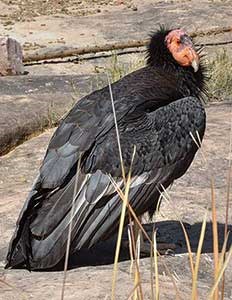
NPS / Grand Canyon National Par
2003
Just nine years after their restoration to the Vermilion Cliffs in Arizona, California condors number 33, with four nesting pairs in Grand Canyon National Park.
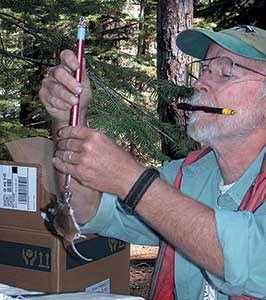
Photo by Leslie S. Chow
2003
Scientists from the University of California–Berkeley and the US Geological Survey repeat historical vertebrate surveys in Yosemite pioneered by renowned field biologist Joseph Grinnell. The original Yosemite work took place in 1914 as part of a series of statewide surveys that led to Grinnell’s development of the theory of ecological niches. The repeat surveys note shifts in several species’ distribution.
2004
The National Park System Advisory Board establishes a science committee and publishes National Park Service Science in the 21st Century: Recommendations Concerning Future Directions for Science and Scientific Resource Management in the National Parks.
2005
The NPS launches the Planning, Environment, and Public Comment system. Known as PEPC, it integrates NPS environmental compliance and management processes, standardizes a means to collect and respond to public comments on environmental documents, and serves as a uniform project-tracking system for natural and cultural resource management planning.
2006
Management Policies 2006 builds on ecological park management concepts articulated in Faunas 1 and 2, reports that date from the 1930s. It also reflects that scientific thinking has permeated the NPS workforce and management practices.
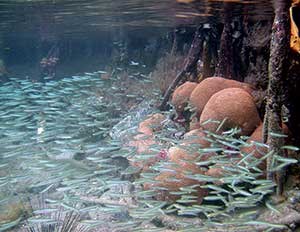
NPS Photo / Matt Patterson
2006
Increasing scientific understanding of marine resource conditions and related management issues leads to the development of strategies for stewardship of ocean and Great Lakes parks.
2008
The NPS and partners initiate the Western Airborne Contaminants Assessment Project (WACAP) to determine the risk to ecosystems and food webs in western national parks from the long-range transport of airborne contaminants. The researchers find measurable amounts of both currently used and historical (banned in the US) contaminants in snow, water, vegetation, fish, and lake sediment at all eight parks covered by the study.
2009
Scenario planning begins to draw attention as an applied science component of the NPS strategy to manage for the implications of climate change for natural environments throughout the National Park System.
2010
After consultation across the Department of the Interior, the NPS publishes “National Park Service Climate Change Response Strategy,” outlining four key components: science, adaptation, mitigation, and communication.
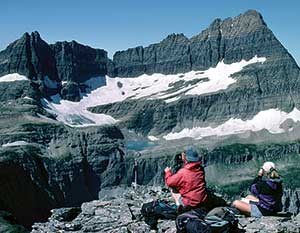
NPS / Glacier National Park
2010
Investigations conducted by USGS research ecologist Dan Fagre since 1991 reveal that the number of glaciers in Glacier National Park, Montana, has fallen from 150 in 1850 to 25. This and the Joshua Tree study (see 2011) are early examples of park-based research illustrating the challenges of protecting key park resources from changes related to climate.
2010
All 32 planned ecoregional networks, comprising 272 park system units with significant natural resources, have monitoring plans and have begun to implement Service-wide protocols for monitoring air, water, biological, and geologic resources and ecosystem functions.
2011
The journal article “Past and Ongoing Shifts in Joshua Tree Distribution Support Future Modeled Range Contraction,” by Cole et al., published in Ecological Applications, examines the possible loss of the park namesake species to climate change. This publication exemplifies a type of research called climate change vulnerability analysis and the application of science to conservation under climate change.
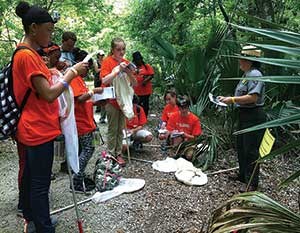
NPS Photo
2011
The National Park Service makes biodiversity discovery a priority, announcing the goal of hosting bioblitzes in 100 parks by 2016. This target will be surpassed in 2014, and a single bioblitz at Golden Gate National Recreation Area draws more than 9,000 participants. As of 2016, 129 parks across the nation will have been “blitzed.”
2012
The National Park System Advisory Board reviews recommendations from the 1963 Leopold Report and issues Revisiting Leopold: Resource Stewardship in the National Parks. This report reiterates that the NPS should focus on expanding the roles of science in the parks and monitoring of natural resources, and on complying with all applicable national laws.
2016
The NPS Natural Resource Advisory Group completes “Natural Resource Stewardship and Science Framework: Four Pillars to Guide Natural Resource Activities and Investments.” The document guides science and stewardship investments and articulates the diverse actions necessary to conserve natural resources in the National Park System, including addressing day-to-day challenges, managing park resources amid continuous change, leveraging for conservation at the landscape level, and enhancing access to and facilitating understanding of applied science for park management.
Introduction to the Science and Natural Resource Management for the National Parks: Milestones, 1916-2016 timeline
